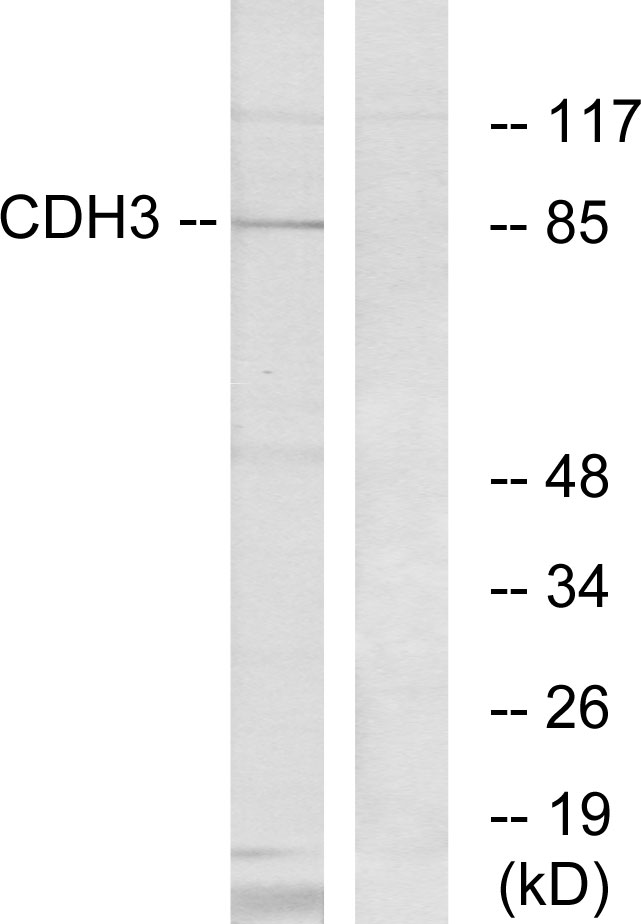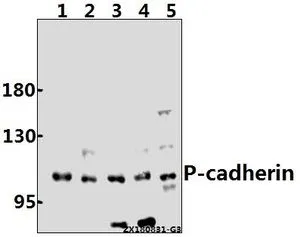![WB analysis of 25 ug of 293T (lane 1), A431 (lane 2) and mouse brain (lane 3) using GTX19350 P-Cadherin antibody [6A9]. Dilution : 1:500 WB analysis of 25 ug of 293T (lane 1), A431 (lane 2) and mouse brain (lane 3) using GTX19350 P-Cadherin antibody [6A9]. Dilution : 1:500](https://www.genetex.com/upload/website/prouct_img/normal/GTX19350/GTX19350_1569_WB_w_23060620_343.webp)
WB analysis of 25 ug of 293T (lane 1), A431 (lane 2) and mouse brain (lane 3) using GTX19350 P-Cadherin antibody [6A9]. Dilution : 1:500
P-Cadherin antibody [6A9]
GTX19350
ApplicationsImmunoFluorescence, ImmunoPrecipitation, Western Blot, ImmunoCytoChemistry, Neutralisation/Blocking
Product group Antibodies
TargetCDH3
Overview
- SupplierGeneTex
- Product NameP-Cadherin antibody [6A9]
- Delivery Days Customer9
- Application Supplier NoteWB: 1:100-1:1000. ICC/IF: 10 microg/ml. *Optimal dilutions/concentrations should be determined by the researcher.Not tested in other applications.
- ApplicationsImmunoFluorescence, ImmunoPrecipitation, Western Blot, ImmunoCytoChemistry, Neutralisation/Blocking
- CertificationResearch Use Only
- ClonalityMonoclonal
- Clone ID6A9
- Concentration1 mg/ml
- ConjugateUnconjugated
- Gene ID1001
- Target nameCDH3
- Target descriptioncadherin 3
- Target synonymsCDHP, HJMD, PCAD, cadherin-3, cadherin 3, type 1, P-cadherin (placental), calcium-dependent adhesion protein, placental
- HostMouse
- IsotypeIgG1
- Protein IDP22223
- Protein NameCadherin-3
- Scientific DescriptionThis gene encodes a classical cadherin of the cadherin superfamily. Alternative splicing results in multiple transcript variants, at least one of which encodes a preproprotein that is proteolytically processed to generate the mature glycoprotein. This calcium-dependent cell-cell adhesion protein is comprised of five extracellular cadherin repeats, a transmembrane region and a highly conserved cytoplasmic tail. This gene is located in a gene cluster in a region on the long arm of chromosome 16 that is involved in loss of heterozygosity events in breast and prostate cancer. In addition, aberrant expression of this protein is observed in cervical adenocarcinomas. Mutations in this gene are associated with hypotrichosis with juvenile macular dystrophy and ectodermal dysplasia, ectrodactyly, and macular dystrophy syndrome (EEMS). [provided by RefSeq, Nov 2015]
- Storage Instruction-20°C or -80°C,2°C to 8°C
- UNSPSC12352203

![ICC/IF analysis of A2058 Cells using GTX19350 P-Cadherin antibody [6A9]. Cells were probed without (right) or with(left) an antibody. Green : Primary antibody Blue : Nuclei Red : Actin Fixation : formaldehyde Dilution : 1:20 overnight at 4oC ICC/IF analysis of A2058 Cells using GTX19350 P-Cadherin antibody [6A9]. Cells were probed without (right) or with(left) an antibody. Green : Primary antibody Blue : Nuclei Red : Actin Fixation : formaldehyde Dilution : 1:20 overnight at 4oC](https://www.genetex.com/upload/website/prouct_img/normal/GTX19350/GTX19350_365_ICC-IF_w_23060620_251.webp)
![ICC/IF analysis of BEAS-2B Cells using GTX19350 P-Cadherin antibody [6A9]. Cells were probed without (right) or with(left) an antibody. Green : Primary antibody Blue : Nuclei Red : Actin Fixation : formaldehyde Dilution : 1:20 overnight at 4oC ICC/IF analysis of BEAS-2B Cells using GTX19350 P-Cadherin antibody [6A9]. Cells were probed without (right) or with(left) an antibody. Green : Primary antibody Blue : Nuclei Red : Actin Fixation : formaldehyde Dilution : 1:20 overnight at 4oC](https://www.genetex.com/upload/website/prouct_img/normal/GTX19350/GTX19350_366_ICC-IF_w_23060620_354.webp)
![ICC/IF analysis of HeLa cells using GTX19350 P-Cadherin antibody [6A9]. Cells were probed without (right) or with(left) an antibody. Green : Primary antibody Blue : Nuclei Red : Actin Fixation : formaldehyde Dilution : 1:20 overnight at 4oC ICC/IF analysis of HeLa cells using GTX19350 P-Cadherin antibody [6A9]. Cells were probed without (right) or with(left) an antibody. Green : Primary antibody Blue : Nuclei Red : Actin Fixation : formaldehyde Dilution : 1:20 overnight at 4oC](https://www.genetex.com/upload/website/prouct_img/normal/GTX19350/GTX19350_367_ICC-IF_w_23060620_952.webp)




